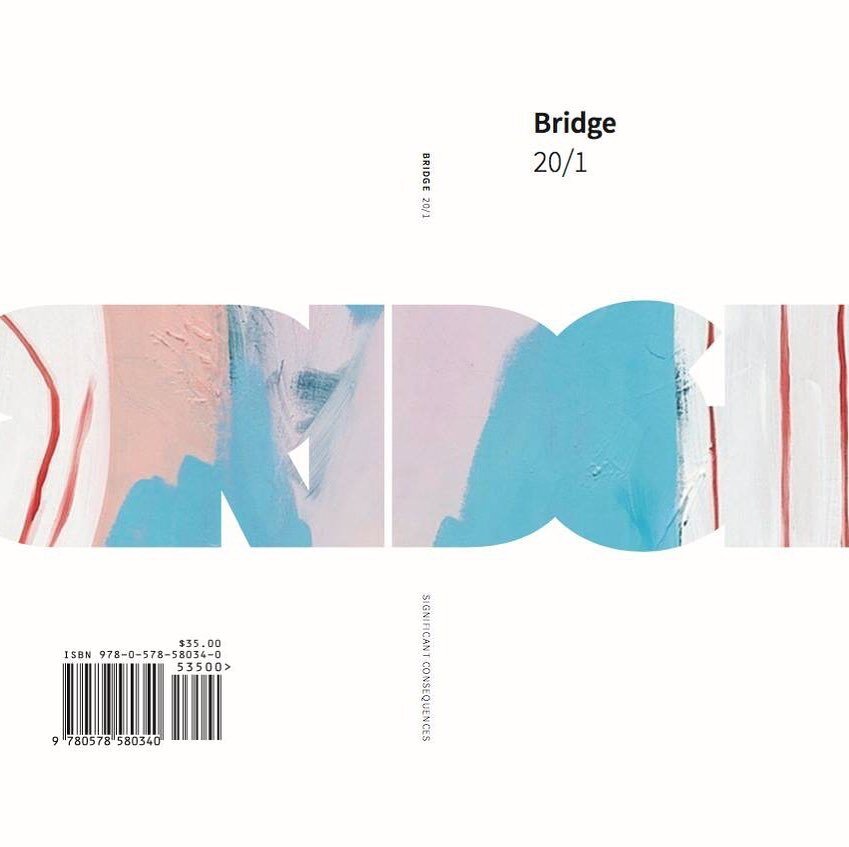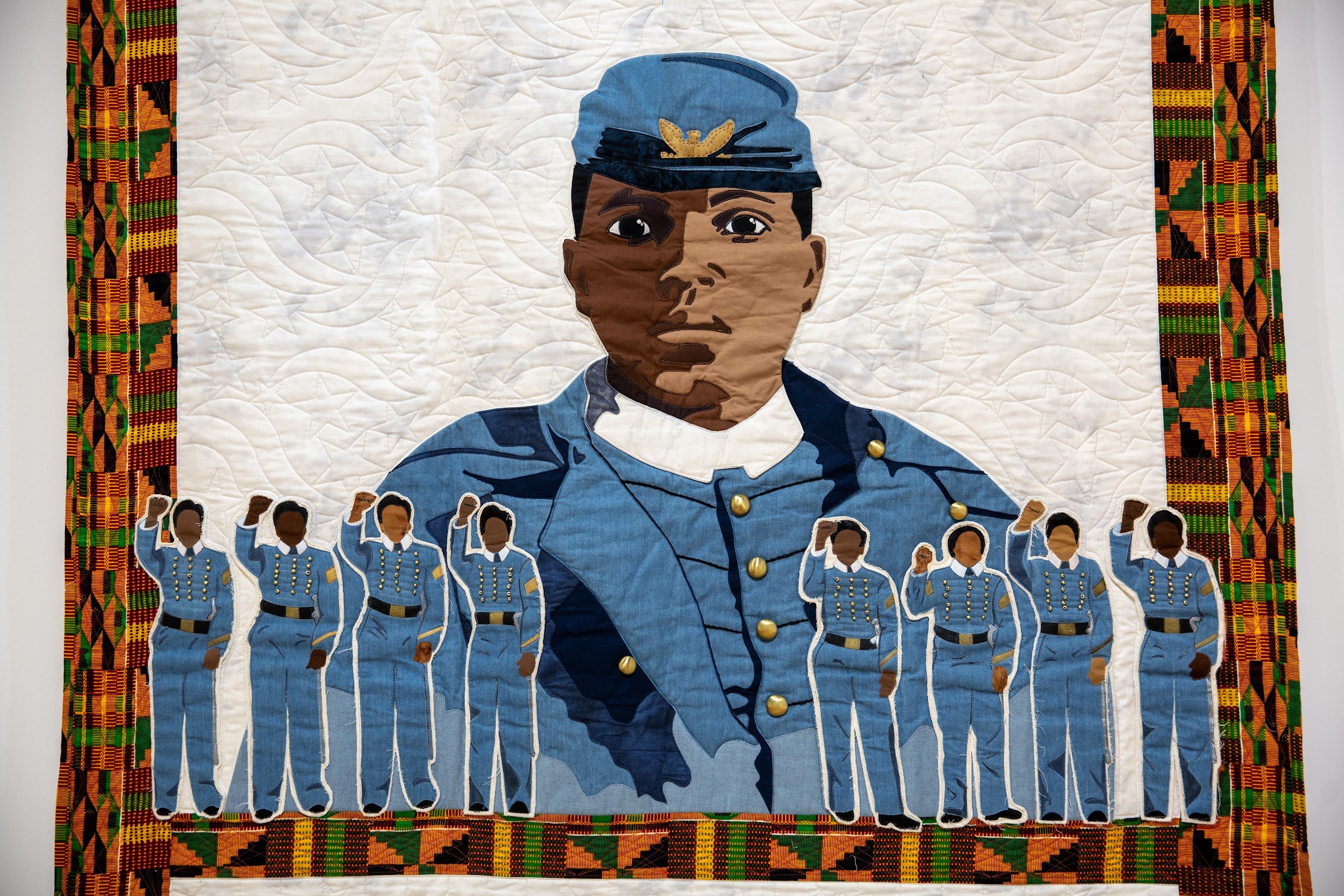REVIEW: Coming to Terms: A Review of "Surviving the Long Wars: Transformative Threads" at the Chicago Cultural Center
Dorothy I. Burge (b. 1954) [US Military family member]. “We Stand on the Shoulders of Our Ancestors,” 2018 (detail). Cotton fabric and batting, buttons, beads, embroidered patch, printing on fabric, photo-transfer on fabric. Machine-quilted by Judy Wolff. Courtesy of the artist. Photo: Eric Perez.
REVIEW
Surviving the Long Wars: Transformative Threads
Chicago Cultural Center
78 E Washington St.
Chicago IL 60602
Dec. 9, 2023—Dec. 8, 2024
By Charles Venkatesh Young
While most art today is shown in bare-bones white cubes which do nothing for the work that lies within, certain venues are able to impart an ineffable vitality on their inhabitants. Whatever’s shown on their interior is assimilated flawlessly into the space and, in a process only attributable to magic, suffused with new life. It’s no coincidence that most of these spaces—think of the Tate Modern’s Turbine Hall or the Guggenheim’s ubiquitous spiral ramp—are grand beyond conception, decked out with high ceilings and opulent skylights. Every one of these boxes is checked by the Grand Army of the Republic (GAR) Hall at the Chicago Cultural Center, where a topical show entitled “Surviving the Long Wars: Transformative Threads” is on view until December.
The most memorable exhibits in these spaces tend to be those which do the least, letting the space work its magic. (Hence the adulatory praise afforded to Olafur Eliasson’s unembellished sun at Turbine Hall or Gego’s rudimentary geometries shown at the Guggenheim.) “Surviving the Long Wars: Transformative Threads” is no exception, allowing the GAR Hall’s monumental ornateness—gilded lunettes with inlaid floral decoration, ten-light chandeliers hung by chains, and a coffered ceiling with more awe-inspiring starbursts than I could count—to frame and inform its ideological project.
Melissa Dowd (Ojibwe, b. 1971) [US Army veteran]. Bullet Dress, 2016. Army uniform with 365 bullet casings. Courtesy of the artist. Photo: Eric Perez.
The exhibit itself taps into the replete history inherent in the room which it occupies—as you might’ve guessed, the GAR Hall honors the group of Union veterans from which it takes its name. Seeing the Civil War battles emblazoned in the room’s walls, you’re liable to feel a swell of pride. America was once backwards, but now that these brave men have driven out the sin of slavery, order has been restored. “Surviving the Long Wars” seeks to disrupt this myopic conception of American history, drawing attention to the ongoing injustices inflicted by American military forces domestically and abroad. The poignant works it foregrounds offer pointed critiques of militarism without venturing too far into solipsistic anecdote or abstruse theory.
Miridith Campbell (Kowa. B. 1966) [US Marine Corps, Army, and Navy veteran]. Marine Corps Dress—Southern Style, 2022. Tanned and smoked buckskin hide; antique, vintage and contemporary beads; red broadcloth English wool; vintage Marine Corps service buttons; hawk bells, horse hair. Courtesy of the artist. Photo: Eric Perez.
Time and time again, the featured artists prove that military violence—no matter how virulent and shocking it may be—cannot escape the trenchant aesthetic frameworks they call home. Take Mahwish Chishty’s MQ-9/5, where the title unmanned aerial vehicle—commonly used to carry out drone strikes in Chishty’s country of birth, Pakistan—has been adorned with the gaudy, bright geometries prominent in South Asian truck art. It’s morbidly hilarious—a drone lauded for its stealth kitted out in bright green and gold. It’s shown alongside Miridith Campbell’s Adobe Walls Battle Dress, a white garment inscribed with scenes of warfare between Campbell’s Kiowa ancestors and Kit Carson’s troops. Each work was digitally transcribed from a series of ledger drawings, in which Kiowa soldiers limned their victories onto the very military ledgers which sought to destroy them. No matter how great the loss of life inflicted upon their people, Chishty and Campbell refuse to give up their aesthetic modes, an act which seems to render their military oppressors pathetic.
Miridith Campbell (Kiowa, b. 1966) [US Marine Corps, Army, and Navy veteran]. Counting Coup, 2002. US cavalry coat, seed beads, and buckskin, courtesy of the artist. Photo: Eric Perez.
Complementary works by Ojibwe artist Melissa Doud—who contributed an American Indian jingle dress made using bullet casings from her military tenure in Iraq—and Dorothea I. Burge—whose featured quilt meditates on the uneasiness experienced by Black West Point graduates in a majority-white class—are plaintive yet triumphant coming-to-terms with serving the very institution which has wronged you.
Yet too often throughout the show were these multifaceted works—replete with subliminal nuances of joy and sorrow—weakened by overtly didactic wall text. While the exhibit organizers have done a fantastic job selecting artists whose work is more rewarding seen grouped together than alone, each contributor deals with a specific ripple from the military’s cataclysmic history—too often are these profoundly different wavelengths collapsed into a single point by the Procrustean accompanying text. And the discussion questions which accompany each section of the show (one reads, “How do these works reckon with the ongoing violent histories of the US long wars, while imagining more powerful futures?”) serve rather bland, one-dimensional readings of the featured art. Quality work shown in a venue like this one speaks for itself—we must be careful not to drown it out.
Charles Venkatesh Young is a journalist and art critic based in Chicago. He contributes to Newcity and Bridge and is the founder of online arts journal Meaning Without Form (which can be visited at meaningwithoutform.com).
Like what you’re reading? Consider donating a few dollars to our writer’s fund and help us keep publishing every Monday.





